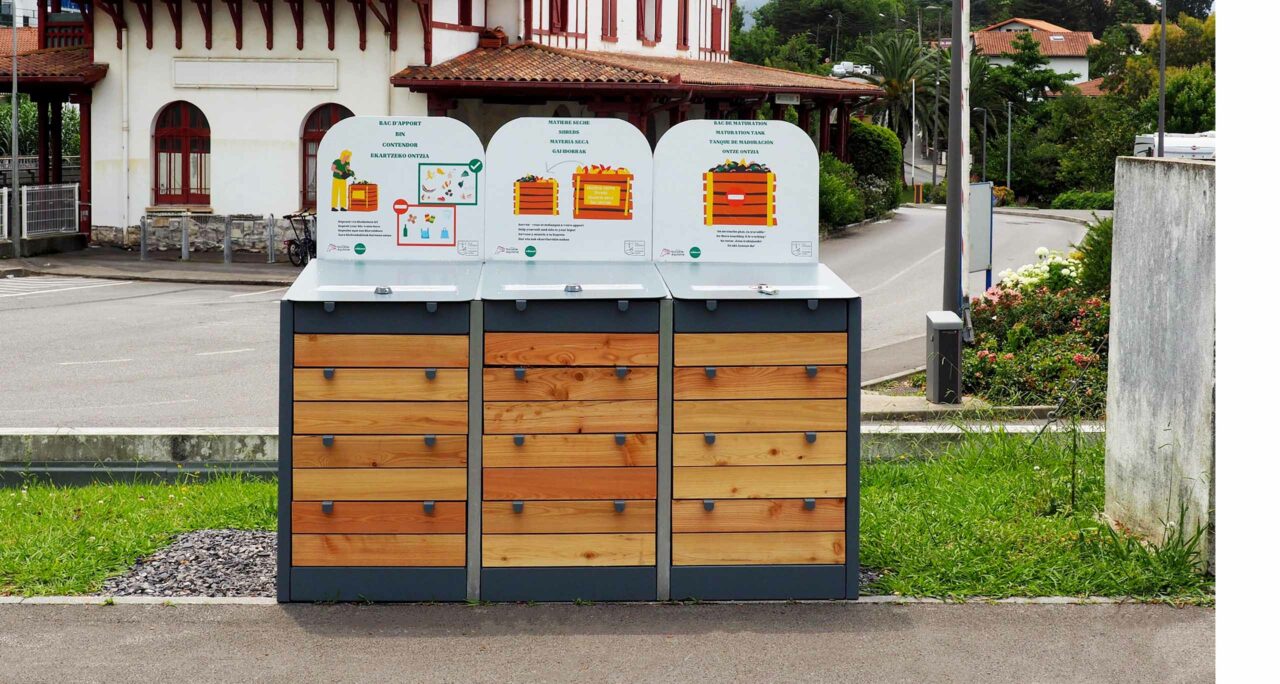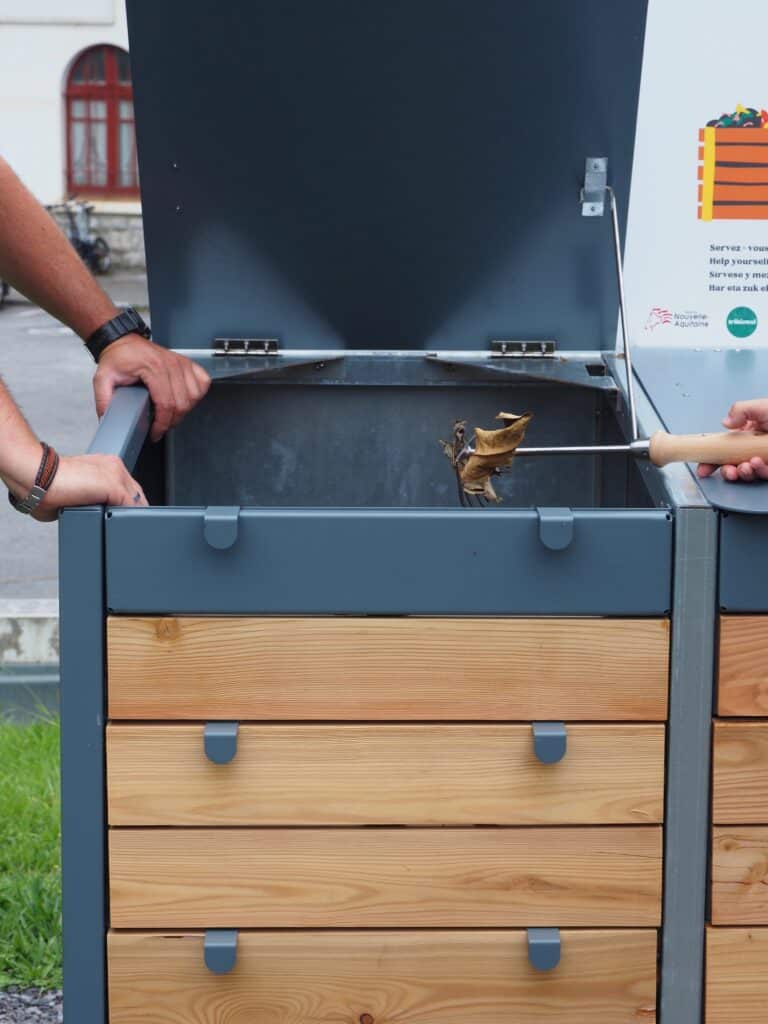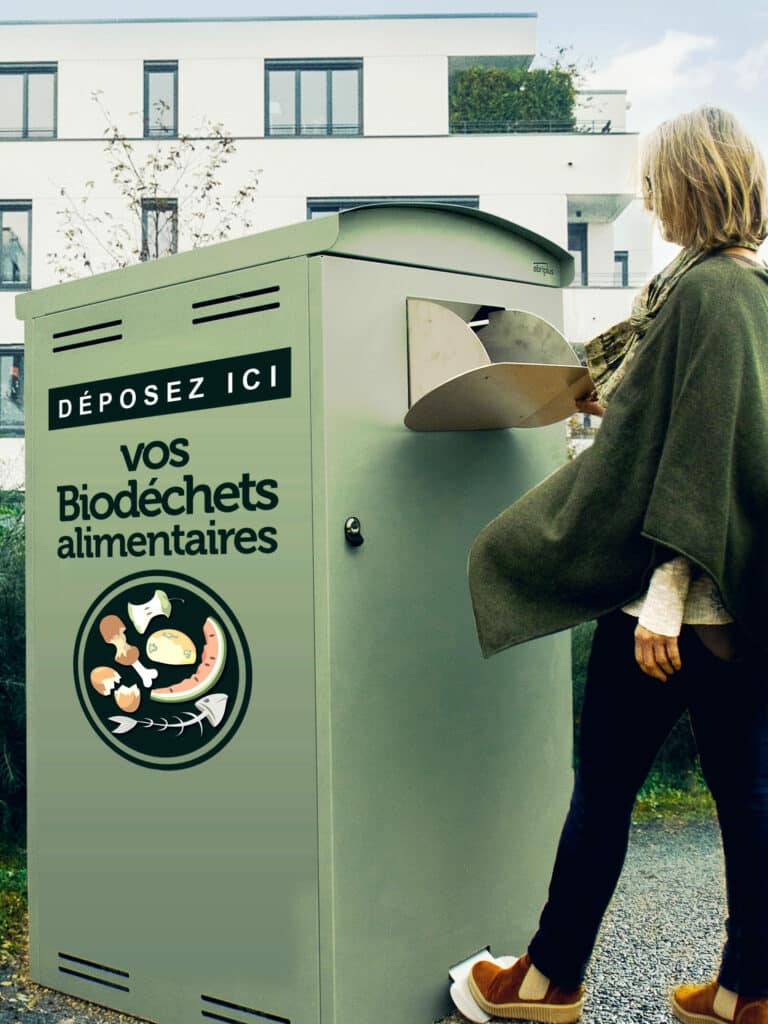Organize your local bio-waste sorting and recovery area

From January 1, 2024, the AGEC law requires all French households to be equipped with a solution for sorting their organic waste. In concrete terms, local authorities are obliged to provide a solution for sorting biowaste. This food waste will then be composted or methanized.
Already implemented in many households, the sorting of biowaste (also known as organic waste) remains a novelty for many. That’s why we’ve put together a guide to help you make the switch to this practice, which is accessible to everyone!
WHAT IS BIOWASTE?

Biowaste – organic waste – is defined by law as “Non-hazardous biodegradable garden or park waste, food or kitchen waste from households, offices, restaurants, wholesalers, canteens, caterers or retail outlets, as well as comparable waste from food processing plants”.
In other words, this includes green waste (lawn clippings, dead leaves, small branches, twigs, hedges, nuts, bark, etc.) and food waste (meal leftovers, meal preparations, expired products, eggshells, small bones, fruit and vegetable skins, etc.).
In some cases, biowaste can also come from animal husbandry.
WHY SORT BIODEGRADABLE WASTE?
In France, residual household waste represents 254kg / year, of which 83kg at source is putrescible. This waste represents a highly valuable resource that meets the soil’s need for organic matter. Separating it from other household waste creates a circular economy for organic matter and reduces the weight of residual waste. Three main objectives have been identified:
- Reduce the waste sector’s carbon footprint by reducing the storage and combustion of waste.
- Produce biogas for local use or for the natural gas grid.
- To supply farmers and green space managers with organic fertilizer and thus improve the agronomic quality of soils.
HOW TO ORGANIZE BIODEGRADABLE WASTE SORTING AREAS?
What are the solutions?
There are many ways to sort and recycle biowaste. These include individual solutions (backyard composting, worm composters, door-to-door collection) and collective solutions (drop-off points, local collective composters). A few months ago, we wrote an article on the subject, still available here: Sorting bio-waste: which solutions to choose?
At Abriplus, we offer solutions for the sorting and local collective composting of biowaste. These solutions are effective in democratizing and popularizing the practice, particularly in urban environments.
OUR PRODUCTS
To meet the needs of both small and large communities, our teams have designed effective, long-lasting products for sorting organic waste at the point of collection and/or for collective composting.
For composting :
The BioCompost collective composter is a compost bin for vegetable waste. Made in our workshop, it’s built to last! Perfectly suited to large-scale collective use, this composter shelter can hold up to 4 bins that can be assembled to meet the different stages of biowaste composting: shred storage bin, biowaste input bin, compost maturation bin and mature compost bin.
Product benefits: The composter has been designed to prevent any pest intrusion thanks to an anti-rodent grid. What’s more, its galvanized steel structure ensures long-lasting durability.
How can I ensure that my shared composting project runs smoothly? You can enlist the help of a master composter. Their job is to ensure that the composting process runs smoothly. One or more people from the residence or neighborhood can also volunteer to take charge of the project. In any case, it’s highly recommended to identify one or more people responsible for managing the flows, communication and composting. This will also ensure that neighbors are mobilized to make the project a success.
For sorting and collecting biowaste
In the same vein as the glass waste collection points, we have created theBioCollect shelter for food waste. This shelter enables residents to drop off their food waste at collective pre-collection points.
Product benefits: The BioCollect is equipped with anti-odour perforations, a watertight, soundproof stainless steel trapdoor and a foot pedal for opening. And it’s no coincidence that the roof is vaulted to prevent any unauthorized dumping of waste.
How to ensure the success of Biocollect installations? The BioCollect has a large communication surface, which is the first and best way to encourage users to drop off their food waste. Make sure you have enough of them. The French Environment and Energy Management Agency (ADEME) recommends placing them no more than 150-200 meters from the target homes. Finally, plan for a sufficient number of collection and cleaning operations. A dirty, smelly bins can put people off depositing their biowaste.
WHERE TO PLACE THEM?
These solutions are particularly well suited to urban environments. The positioning of your bin shelters must be strategic and practical for both residents and local authority services.
Bio-waste bin shelters should be placed throughout a given area, so that every resident can find a drop-off point close to his or her home.
Collective composters, meanwhile, should be placed in areas with green spaces to ensure that the compost functions properly.
HOW TO COMMUNICATE ON IT?
It’s important to communicate about the new food waste sorting solution to encourage residents to get involved. Our products have been designed to offer an attractive adhesive surface. So it’s easy to apply stickers that explain the function of the shelter, how it works, the fate of its contents… It can also be very useful to list the different shelters in a town on its website, so that consumers can find them easily. This important step in the bio-waste collection process will familiarize residents with the new systems and encourage them to participate.
You now have the keys to efficiently organizing your local bio-waste sorting and recovery areas. Don’t hesitate to contact us to find out more about our products, or to get expert advice on the solution best suited to your project.
Share this article

